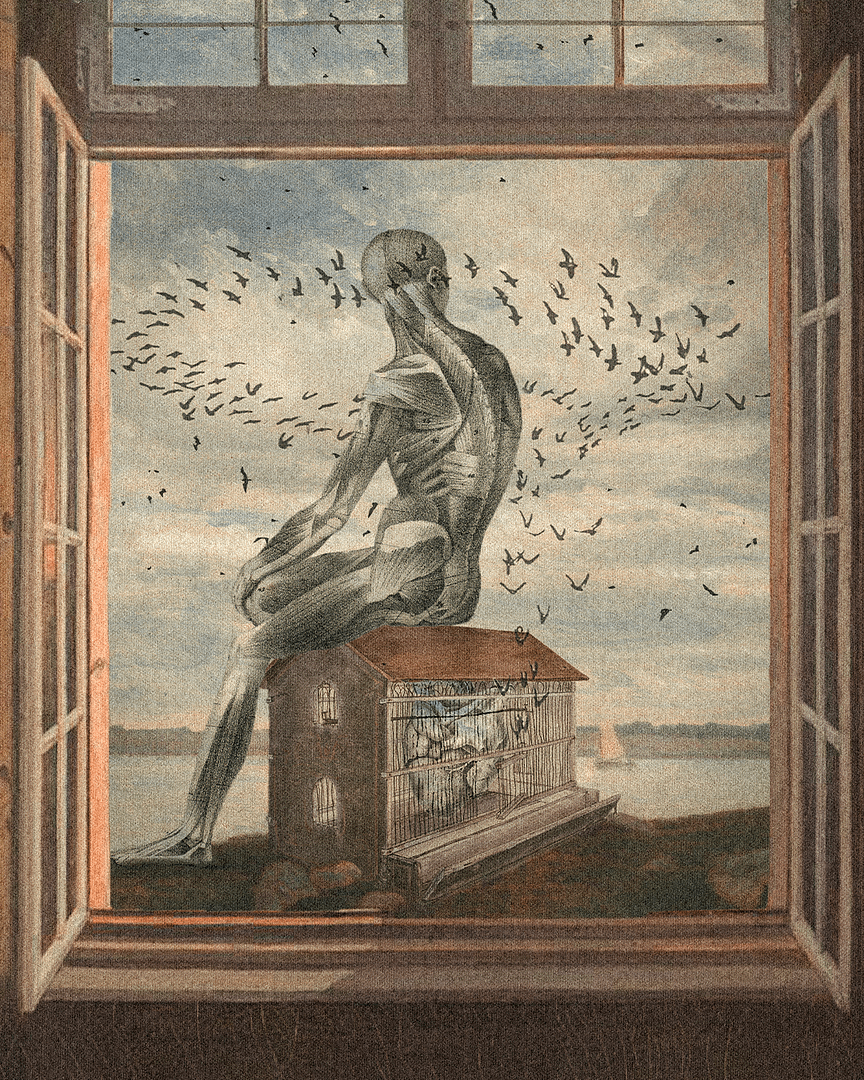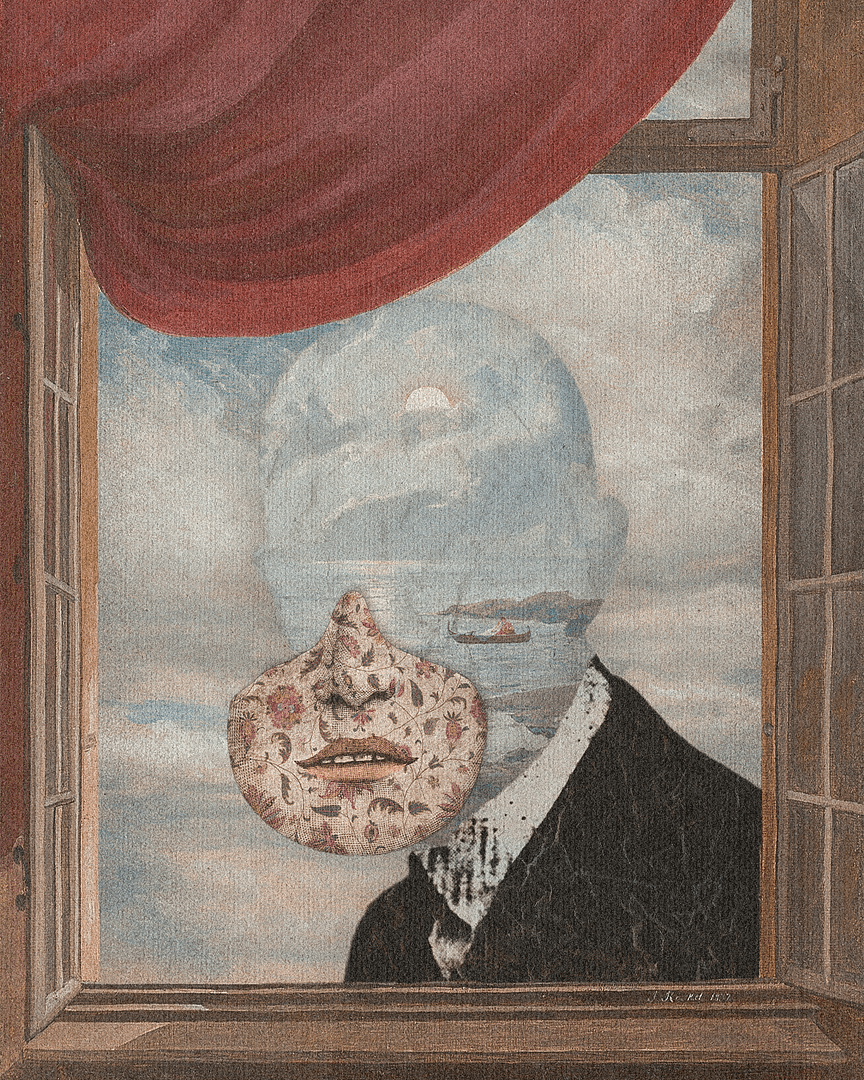
D: It’s been a long, long time since we last did one of these, but we’re finally back with a brand new featured artist interview! This time around, I’ll be having a chat with Josh Dickens, also known as @reflective_abyss!
Without further ado, please briefly introduce yourself to our readers, Josh! Who are you, where are you from, how long have you been in the art game, and what’s your primary medium of choice?
J: Hey! I’m Josh Dickens, a multimedia artist from North Carolina, USA. I work in a few different mediums, such as drawing, sculpture, and digital art, but collage is where I feel most at home. Most of my pieces are made using old lithograph etchings from the 16-1700s, which I rework into something new and often a little eerie.
I’ve been making art for about ten years, but I didn’t really start taking it seriously until around 2022. That’s when I set up my first booth and started selling at markets across North Carolina. Since then, things have grown a ton. I now run a nonprofit called Artists Escape, which is a pop-up maker space focused on building community and offering free creative workshops and events in my hometown. It’s been amazing to help create a space where people can connect, make art, and just be themselves.
D: The way in which you use those old illustrations in your collages really gives them an idiosyncratic touch. How long did it take before you ‘found’ your aesthetic, and what is it that attracts you to this particular type of art?
J: I actually started out making posters for local bands and was heavily inspired by the art that came out of the jam band and psychedelic scenes. Super textured, surreal, and layered stuff. But I didn’t really find my style until I joined in on Oculustober a couple of years ago.
The time crunch of daily prompts forced me to stop overthinking and just make. I ended up trying out a bunch of different techniques and aesthetics, and somewhere in that chaos, my visual language started to form. Since then, I’ve leaned into combining anatomical imagery with elements from old paintings and etchings—usually from the 1600s and 1700s. There’s something haunting and beautiful about those old images, and remixing them into new contexts lets me explore themes like grief, identity, and transformation in a way that feels personal and symbolic.
D: There’s definitely something special about those old images. If I’ve got my timeline correctly, you originally started out primarily working digitally, and only started making analog collages later on, right? How was the transition between the two mediums for you? Did you have to rethink any parts of your usual approach?
J: Yeah, that’s right. I started out with digital collage mostly because I already had a background in Photoshop from high school. When local bands asked me to make posters, digital tools were just the most accessible thing. Once I discovered the massive archives of royalty-free images online, especially old anatomy textbooks and lithograph etchings, I really got hooked on that antique style.
The shift to analog came after I found some Jim Harter image archive books in a thrift store. Around that time, I was also in a more stable place financially and could start collecting physical materials to work with. I still go back and forth between digital and analog depending on the piece. Analog collage forces me to be more flexible and less perfectionist—I can’t just resize or recolor an image, so I have to work with what I’ve got, and that constraint pushes me to be more creative. But I still love digital for the freedom it gives when I have a very specific vision I want to build.
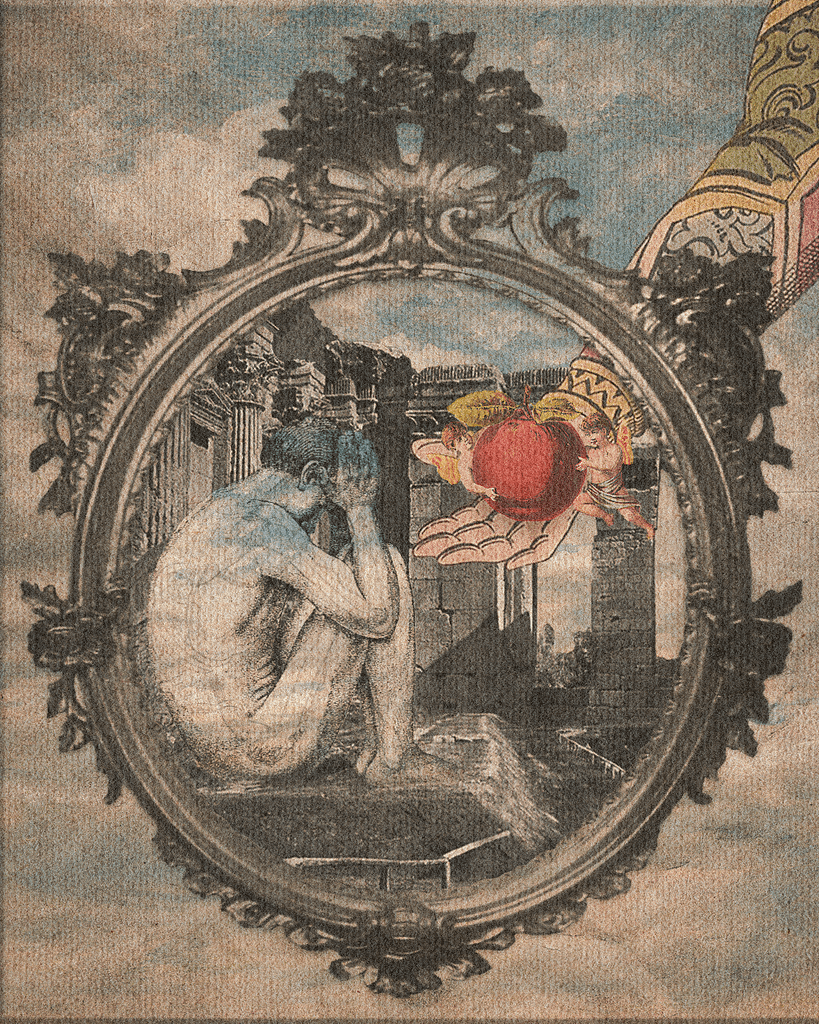
D: Not being able to flip or resize your material Is always one of the trickiest parts when it comes to making analog collages.
Now, this next one is one of those questions I’ve asked just about every collage artist we’ve interviewed so far. What’s your process like? Do you go into a session with a planned-out concept in mind, or are you more into letting the element of chance take the wheel?
J: This is actually one of the reasons I love working with collage, the process can change so much depending on the images I’m using. Usually, I’ll start with a feeling or a thought I want to express, and then I’ll dig through my collection of images to find pieces that resonate with that emotion. Most of the time, I end up finding two or three that just click together in a way I never could’ve planned, and they end up forming a symbol or concept that captures whatever I’m working through.
Once I’ve got that core, I build the rest of the piece around it. But honestly, I just try to follow the images’ lead. That’s what I love about collage, the way unexpected connections show up. It’s like the images already know how they want to be combined, and I’m just the one doing the cutting and piecing it all together.
D: That’s definitely one of the best things about collage. I don’t know if any other medium really comes through with the ‘eureka!’-moments as consistently as collage art.
What’s your workspace like? Do you keep your materials organized in any particular way?
J: Totally agree, those “eureka” moments are what keep me coming back.
Haha, I try to stay organized, but I have a bad habit of starting a bunch of projects at once, so things can definitely get out of hand. I’m super lucky to have a studio now at the Iredell Arts Council, which gives me a lot more room to move around and work. Before that, I was living and creating in a tiny house, which made it hard to do anything large-scale.
Now I’ve got two main work tables, one for holding images, books, and my printers, and the other as my actual workspace for cutting and assembling pieces. I also have a little setup with a record player and an old CRT TV, which helps keep the vibes right while I work.
As for organizing materials, I sort images by the books they came from. I’ll cut full pages out first, then do rough cuts of the images I like and move them into a smaller box. Once they’re fully cut and ready to use, they go into a third box that I pull from when I’m assembling a collage. It’s a bit chaotic, but it works for me.
D: Out of curiosity, what are some of the main influences on your art? Have any visual artists, books, music, or things like that had an impact on you?
J: I’m heavily influenced by artists like Wilfried Sätty and Jim Harter. They’re not super well-known, but they had a big impact on the psychedelic scene in the ’60s with their collage-style poster work. Most of the public domain images I use come from the archives they helped put together.
But honestly, I pull inspiration from all over, 80s sci-fi art, mechanical diagrams, anatomical manuals, Russian animation, and anything with a strange, surreal vibe. I’ve also got a pretty big vinyl collection, and I usually put something on while I work to help shape the mood of a piece.
Thematically, a lot of my work is driven by inner exploration and reflection. Writers like Ram Dass, Alan Watts, Robert Anton Wilson, the Beat Poets and Terence McKenna have been huge influences in how I think about consciousness, symbolism, and transformation. Their ideas definitely weave their way into what I create.
D: You mentioned that you generally let your emotions guide you when making your pieces. Just to stick to the thematical content of your work a bit longer, are there any themes you find yourself recurrently coming back to?
J: Grief and the process of healing from it is a theme I keep returning to. It’s something I’ve had to work through a lot in my own life, and collage has been a powerful way to process those emotions.
Alongside that, love and connection are recurring themes too. They kind of balance out the grief, reminding me that loss and love are often two sides of the same experience. I try not to lean too far into the darkness, though. I always want to keep the bigger picture in mind and create something that ultimately points toward hope or transformation.
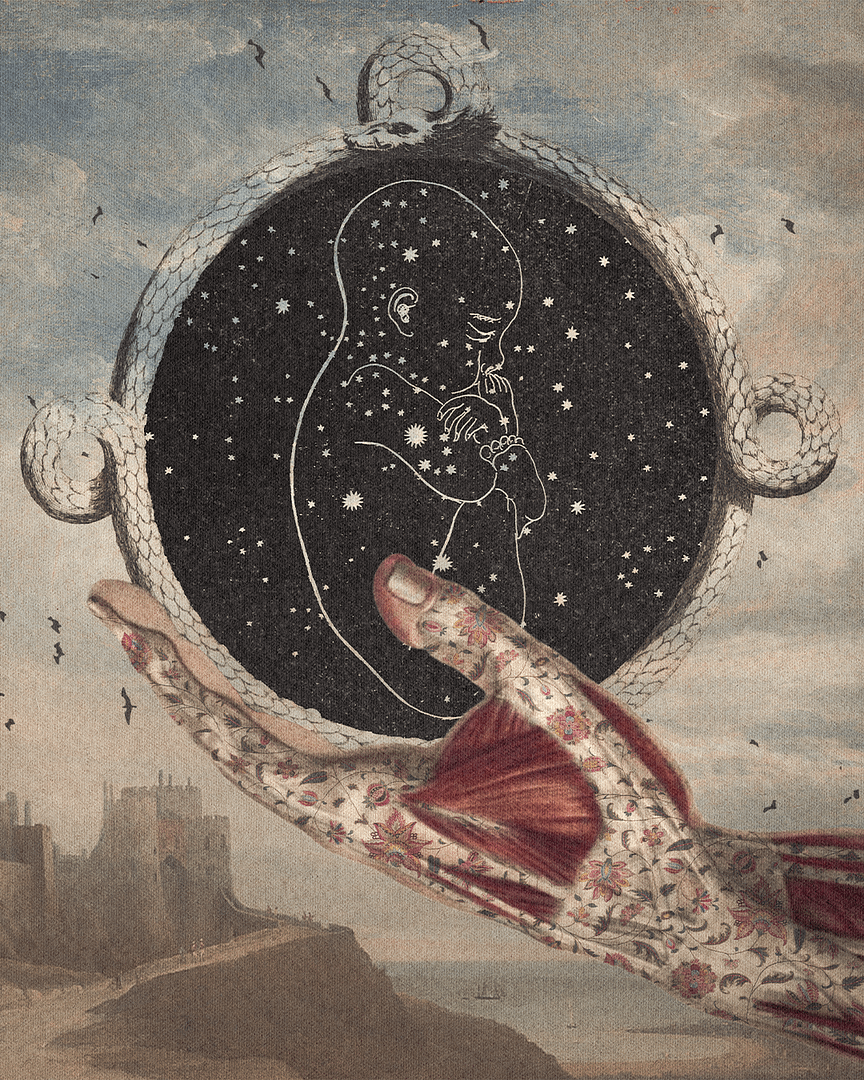
D: Is there any piece you’ve created that’s especially near and dear to you, and if so, what makes it so important?
J: One piece that means a lot to me is my first sculpture, Sudden Grace, which I made last year. It came to me after I was in a really bad car accident. I got T-boned at a crossroads, right between a church and a funeral home, and the only reason the car frame didn’t collapse on me was because I happened to have all my market booth supplies in the car. That experience stuck with me hard.
The vision for the sculpture came to me almost fully formed, and when I built it, it came out nearly identical to what I saw in my head. It was one of the most intense and personal pieces I’ve made, it really feels like a physical symbol of survival and grace.
D: That’s a whole set of freaky coincidences right there, damn. I’m glad you made it out of that accident in one piece. Do you think the experience has had any kind of transformative influence on the work you’ve made in general since then?
J: Yeah, absolutely. That experience definitely woke me up. Since then, I’ve spent a lot less time stressing over things I can’t control, and I try not to waste energy on stuff that doesn’t feel meaningful.
It made me really aware of how fragile everything is, how quickly it can all be gone. Now I’m focused on making and sharing as much as I can while I’m here. That urgency has pushed me to take bigger creative risks and not hold back on the ideas that matter most to me.
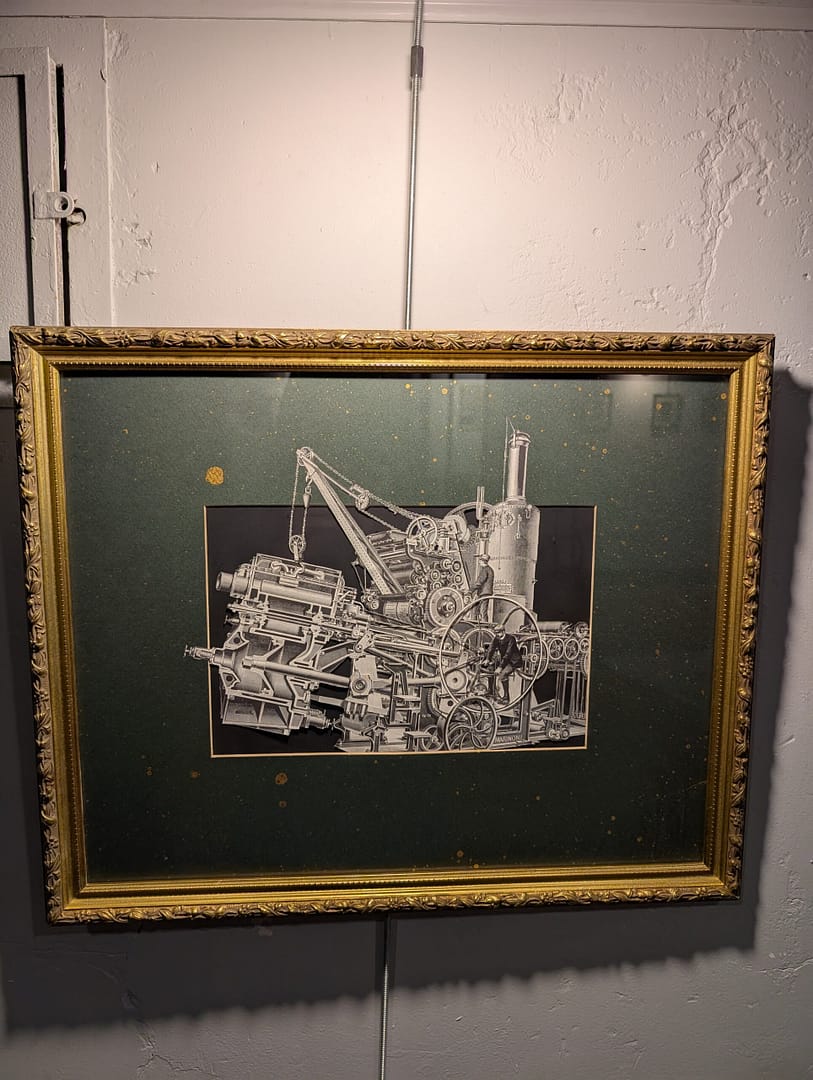
D: So, you recently had your very first solo show. Could you tell us a bit more about that? What was the process of putting it together like, and how did it turn out?
J: It was a lot of work, but I honestly couldn’t be more grateful for how it all came together. I had over 35 pieces hung in the gallery, plus two interactive installations that explored the relationship between humans and artificial intelligence.
On opening night, over 90 people showed up, which was honestly overwhelming, but in the best way. Knowing that so many people came out to support what I do meant the world to me. I’ve always wanted to try installation art, and finally getting the chance to do that, especially with such personal work, was incredible. Seeing how differently people interacted with the installations and hearing their interpretations really reminded me why I create in the first place.
D: That’s awesome! I’m very glad to hear it was such a great success. It can be quite interesting to hear how different people interpret your work. We discussed some of the main recurring themes in your work earlier on. Is it important to you that the audience ”gets” your work the way you intended it to be interpreted, or would you rather like to leave things open to interpretation?
J: I definitely have my own meanings and intentions behind the pieces I make, but when it comes to sharing them, I try to offer as little explanation as possible. I don’t think it’s my job to tell someone how they should feel about a piece. Everyone brings their own emotions, memories, and experiences into a space, and all of that influences how they interpret what they’re seeing.
Maybe they’re in a weird mood, or they just went through something major in their life, or they’re seeing it next to someone they love. All of that matters just as much as what I was thinking when I made the piece. Especially with collage and surrealism, where so much of the meaning comes from symbolism and juxtaposition, I think it’s important to let people form their own connections, even if those interpretations are totally different from what I had in mind.
Once a piece is finished, it’s not really mine anymore in that sense. It becomes a mirror for whoever’s looking at it, and I don’t want to get in the way of that moment of connection.
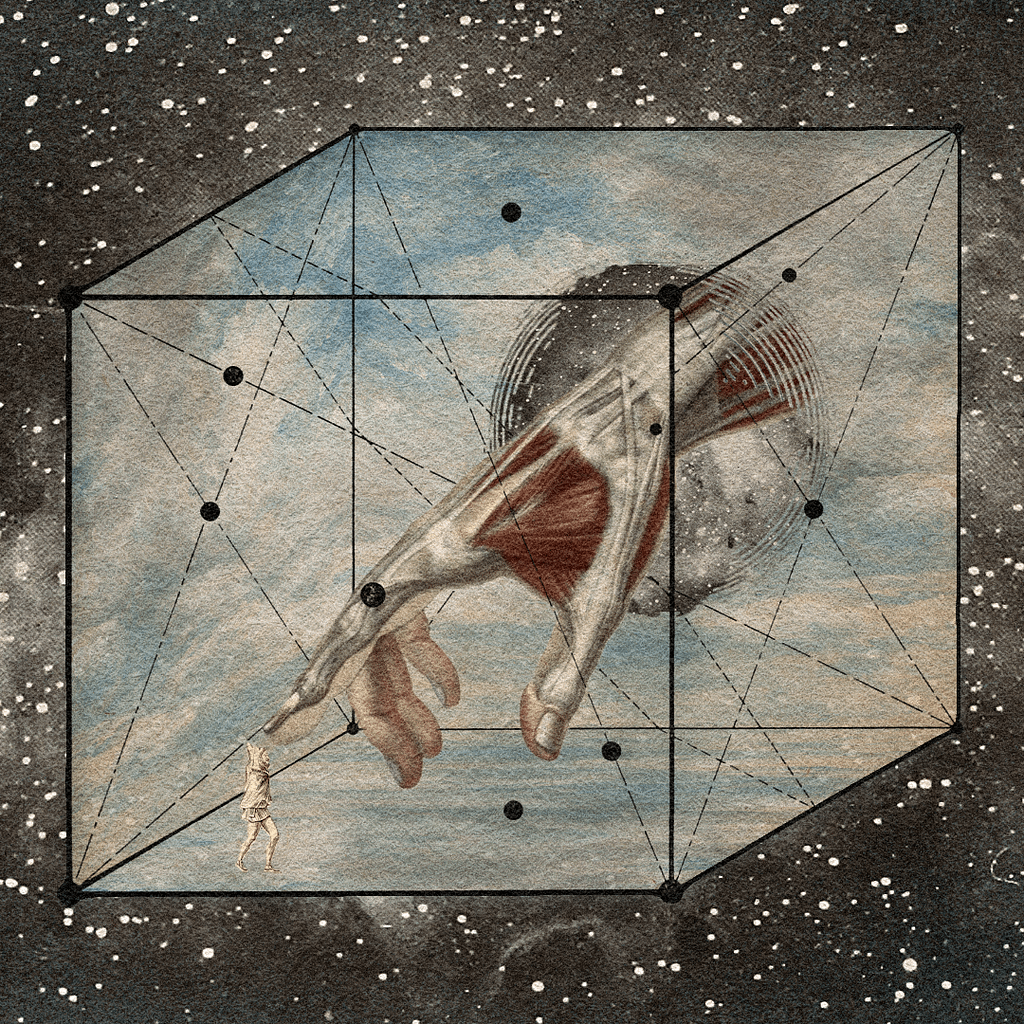
D: You mentioned that a few of the pieces explored the relation between humans and AI. We live in a world in which the online art space is increasingly becoming oversaturated with AI-generated content and is being shaped by the big tech companies’ opaque algorithms. How do you see your position as an artist working in a more traditional medium like collage evolving in this in my opinion rather artist-unfriendly landscape?
J: I’ve actually been experimenting with AI in creative ways for the last six years or so, not just in image generation, but as a tool for problem-solving and conceptual development. I use AI a lot these days for helping me code projects, brainstorm ideas, manage the nonprofit side of Artists Escape, and even plan installation work. So while I understand the concerns around AI-generated art, I’ve mostly seen it as a powerful collaborator, something that can support and expand my creativity, not replace it.
For my two recent installations, I used AI more like a mirror, something for the audience to interact with and reflect on. I wanted to give people a space to confront the technology and form their own opinions based on direct experience. I think that’s really important right now, because AI isn’t going away. As artists, we have the opportunity to explore new and unexpected uses for it, to push its boundaries in ways that feel meaningful and human, rather than just replicating what’s already been done.
Even though this first wave of generative AI feels pretty artist-unfriendly in a lot of ways, I believe we can reclaim some of that space by using it on our terms, to amplify our vision, not override it.
D: The pessimist in me suspects that’s going to be a tricky one, but we’ll see where things go from here… Anyway, now for something completely different: I’ve seen your posts about Artists Escape, and it really looks like you’ve managed to build up quite an awesome, active community! What initially prompted you to set up the project, and what have been some of your most memorable experiences so far?
J: Honestly, it all started out of desperation. When I first moved back to my hometown, I didn’t really know anyone who was doing anything creative, and there wasn’t much happening in the local visual arts scene. I needed a space where I could meet new people, express myself, and feel connected to something.
Through doing art markets, I met my co-director Janice, who really encouraged me to run with this idea I had about creating a makerspace. Now, a little over a year later, it’s been incredible to watch this creative community come to life. One of my favorite moments was our one-year anniversary event, where we brought together visual artists, musicians, and the wider community, and it turned into such a fun and inspiring night. It really felt like the kind of space I had needed all along.
D: The idea behind Artist’s Escape is that it’s accessible for everyone, not just for professional artists, right? In what ways do you try to encourage collaboration and experimentation for those who don’t necessarily consider themselves artists?
J: Yeah, exactly, we keep everything free and open to the public so that anyone, regardless of experience, can come and be a part of it. One of our biggest goals is to make art feel approachable, not intimidating. We have a wide variety of materials available so people can try out different mediums—things they might’ve never touched before, like air-dry clay, collage materials, paint, and more.
We also have an amazing team of volunteers who are always around to help if someone gets stuck or needs a little guidance. To encourage collaboration, we set up ongoing group projects where anyone can contribute. Our first one just wrapped up after about a year—over 30 people added their touch to it. It’s this huge, chaotic, beautiful mix of acrylic paint, collage, embroidery, found objects, colored pencil—you name it. It’s really cool to see so many different voices and styles merge into one shared piece.
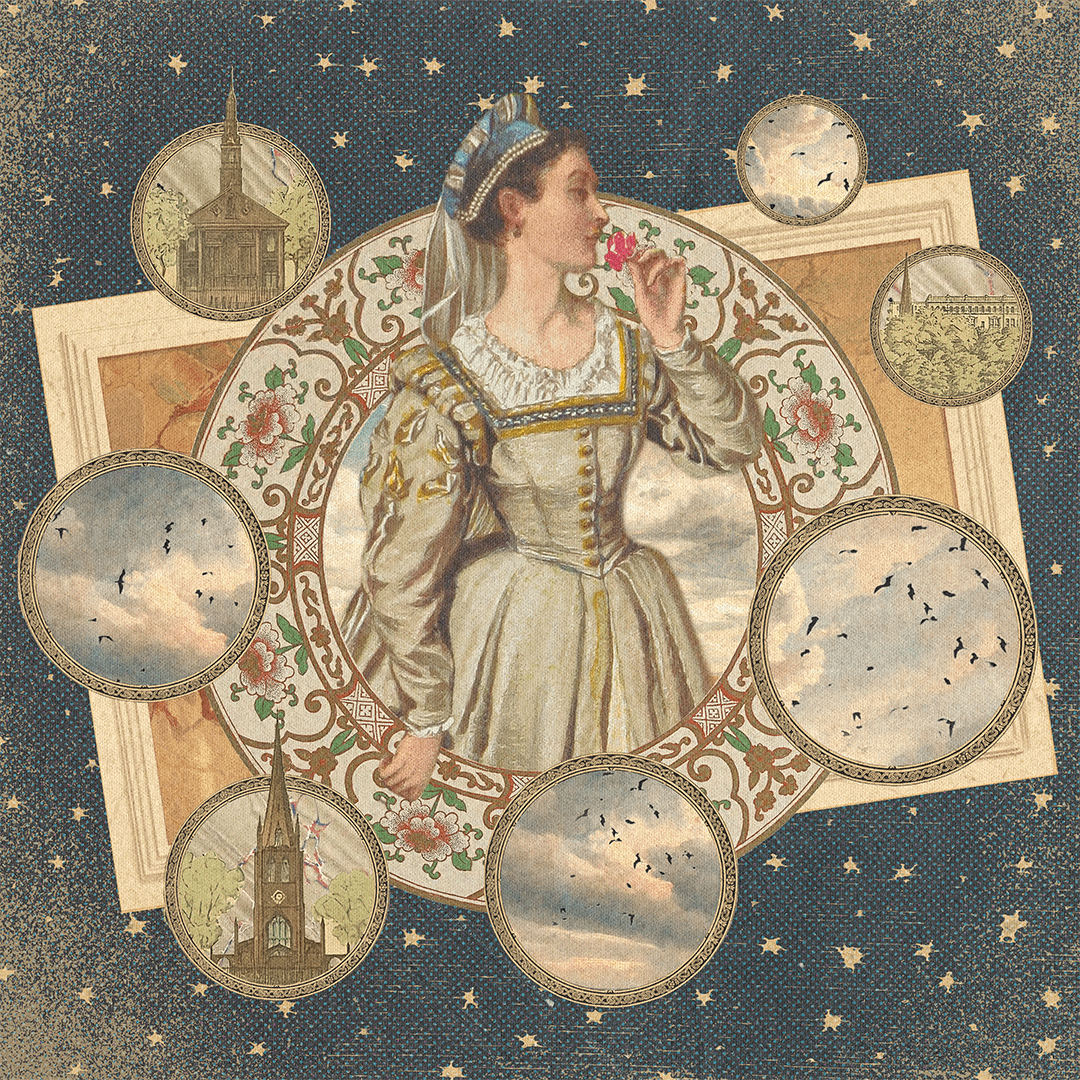
D: That sounds neat! Got any ideas for future collaborative projects yet? Also, just out of sheer curiosity, has this collaborative work (and/or these meetups in general) changed your perspective on your own work in any way?
J: We’ve already started working on our next group canvas, which will probably take another year to finish like the first one. I’m excited to see how it evolves with time and all the different people adding to it.
Working with others through Artist’s Escape has shifted my perspective on my own art. Before, when I hit a block, I’d sometimes walk away from a piece for weeks, or just abandon it altogether. But now, I’m surrounded by people who can help me move through that stuck place. They’ll suggest ideas or approaches I never would’ve thought of on my own. It’s made creating feel less isolated and way more dynamic.
D: Having outsider input and working with others can really make a huge difference when you find yourself stuck. Creating some collaborative pieces with friends helped pull me out of a bit of a creative rut a while ago, too. That being said, it can be tricky sometimes because occasionally you end up getting pushed further out of your comfort zone than you’re used to. Overall, do you find collaboration to be easier or harder than working solo?
J: Honestly, it really depends on the day. I find it way easier to stay in the creative zone for longer periods when I’m around other people who are also making art, it helps me stay focused and inspired. But at the same time, it can be tough to tap into deeper emotions or come up with core concepts when I’m in a crowded room.
Usually, I’ll come up with the idea or emotional direction for a piece while I’m alone, and then I’ll save the more tedious parts, cutting, assembling, refining, for when I’m around others. That way, I get the best of both worlds: solitude for the emotional depth, and collaboration for momentum and encouragement.
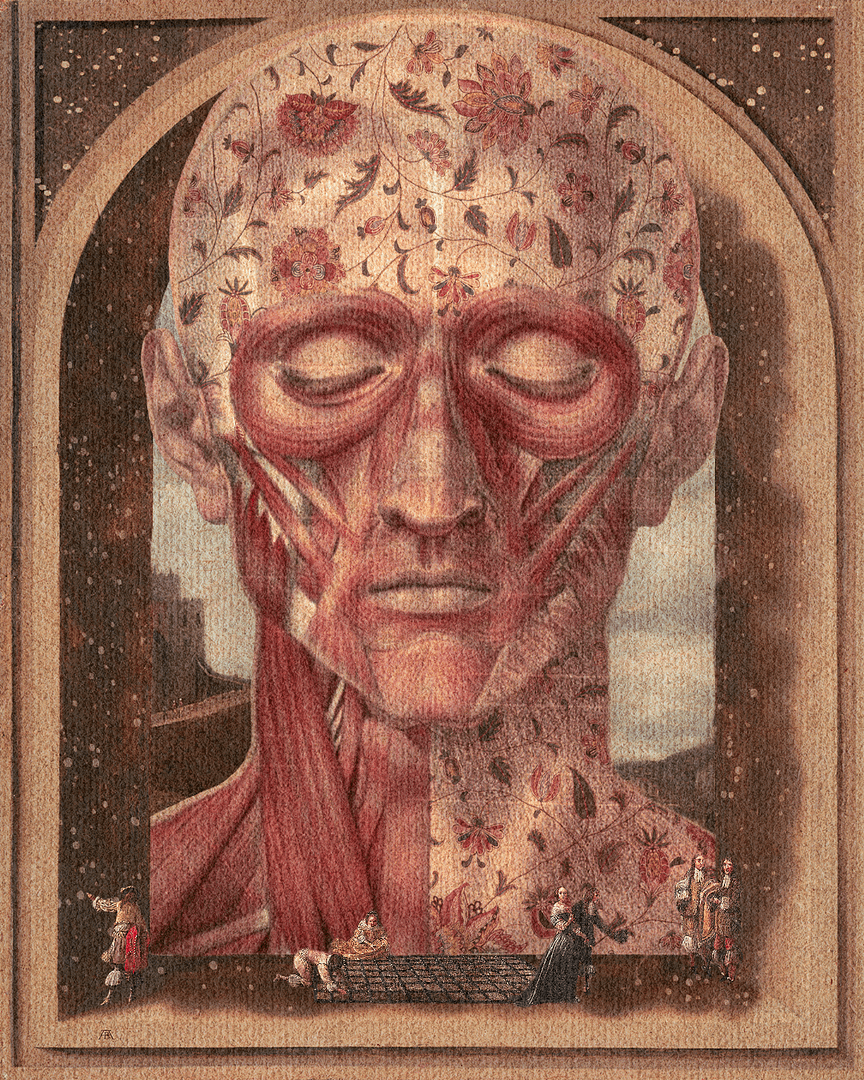
D: What’s been the most challenging part of keeping a project like Artist’s Escape running?
J: The most challenging part has been the business side of things. This is my first time starting anything like this, and I really just dove in without knowing what I was doing. Figuring out how to legally set up a nonprofit and keep it running sustainably has been a big learning curve.
That said, I’ve been lucky to have a really supportive board and community around me. They’ve helped guide things along and keep everything afloat. I couldn’t have done it alone.
D: Do you have any dream projects you’d love to organize through Artist’s Escape? Exhibitions, zines, that sort of thing?
J: I’ve got a ton of ideas for future projects, but the big dream I’ve had for a while is to create a fully immersive art exhibit, kind of like Meow Wolf. I’d love to see a space where artists can collaborate to build entire rooms you can step into, interact with, and experience in a multisensory way.
I’ve always been drawn to art that you can play with, stuff that’s kinetic, makes noise, changes as you move through it. It would be amazing to bring something like that to North Carolina, where people could walk through surreal, collaborative environments built by local artists.
D: I wasn’t familiar with Meow Wolf, but that sort of thing does look pretty damn neat. It’s quite interesting you mention being fascinated by art that’s kinetic in some way, because collage often tends to be rather static and not so suitable for ‘play’. Have you experimented with this type of art before yourself or was there anything in particular that triggered your fascination?
J: The two installation pieces I created for my recent exhibit were actually my first experiments with immersive art. But growing up, my favorite kinds of art experiences were always interactive, especially ones that made sound or involved movement. I’ve always been fascinated by kinetic and sensory-based art, and I was really inspired by children’s museums and science centers. They’d teach complex ideas through hands-on play, and that style of learning has always worked best for me personally.
Seeing that same kind of interactivity brought into “adult” art spaces, like Meow Wolf, has been a huge inspiration. I love the idea of being able to step into an artwork, to feel like you’re inside it rather than just looking at it on a wall. The recent rise of immersive museums has opened my eyes to what’s possible, and it’s definitely sparked some big ideas for the kind of work I want to create going forward.

D: What’s the art scene like over there in general? Earlier on, you mentioned that you kind of started Artist’s Escape out of desperation, but have things changed since then?
J: It’s grown a lot in the last few years! When I first moved back to Statesville, the art scene felt almost nonexistent. But since then, through working with the Iredell Arts Council and organizing free events, we’ve seen the community come back to life.
We just had an event called Art in the Park that brought out over 60 artists as vendors. Just a few years ago, we were lucky if 10 showed up. It’s been incredible to watch that growth happen.
D: I hope you’ll be able to keep that energy going for a long time. I’d also like to thank you for taking the time to chat with me about your work once again, Josh!
As is tradition at this point, I’d like to wrap things up with the shout-out segment of the interview. Basically, now’s your chance to share a little something about the things you’ve been into lately (bands, films, books, and so on), plug some of your friends’ projects, or just give a general shout-out to anyone you feel deserves one. Sky’s the limit!
J: Thank you so much for taking the time to talk with me! It’s been really great having the chance to share more about my work and thought process.
Of course, I’d love for everyone to check out what we’re doing with Artists Escape over at @svlartistsescape. And I’ve got to give a huge shout-out to the amazing team that helps make it all happen, especially my co-director Janice @janicejayart and our event organizer Zak @purple_fuzz_creations. I honestly couldn’t do any of this without their support and guidance over the last couple of years.
Also, if anyone ever finds themselves near Statesville, North Carolina, they should absolutely check out what’s happening at the Iredell Arts Council. It’s housed in our old county jail from 1909, which has been turned into a gallery and music venue. There are free events happening almost every week, exhibitions, concerts, workshops; it’s really become a creative hub for the area. We’re just one of several nonprofits working out of the space; there are some other incredible teams doing amazing things for our community. Roots in the Round, Piedmont Folkways, Insomniacs Inc, and the Full Bloom Film Festival are all grassroots groups made up of passionate people dedicated to bringing homegrown, DIY events to our small town. It’s been inspiring to watch this creative momentum build, and I’m excited to see where it takes us next!
